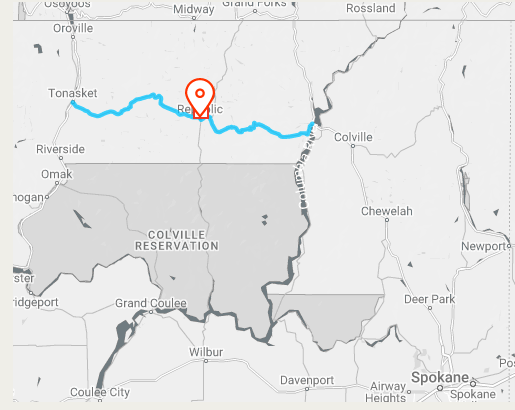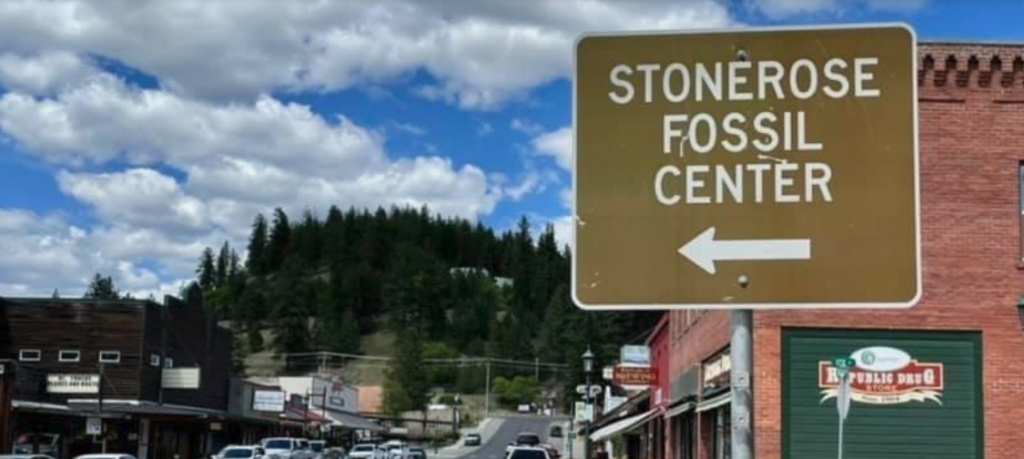Republic, WA – A Thumbnail
Saturday, June 22nd, 2024
Republic is the “jumping-off point” for Friends of MacDonald members when visiting the Ranald MacDonald grave-site in Toroda, WA. Toroda, located along the Kettle River, is a scenic 38-minute drive north from Republic (30.0 mi. via WA-21 N and Kettle River Rd.) Republic is the home of the Ferry County Historical Society and museum (located at 15-2 N. Kean St. across from the Patterson City Park). The featured exhibits include mining and geology displays, a Native American exhibit (high-lighting Ranald MacDonald!) and an array of photos relating to ‘Turn of the Century’ Republic businesses. The museum is open Memorial Day to Labor Day, Friday-Monday from 10 am to 2 pm. Republic, the county seat of sparsely populated Ferry County in Northeast Washington, sprang into existence as a gold-mining camp in 1896 called ‘Eureka’ [or Eureka Gulch]. By 1898 it was crowded with 2,000 miners and prospectors, housed mostly in canvas tents. Several mines, including the Republic Mine, hit lucrative gold veins. The town site was laid out in 1898 and the name changed to ‘Republic’ because Postal authorities refused the name of Eureka (since a town with that name already existed in Clark County). The present name, proposed by citizens to honor the “Great Republic mining claim”, was accepted. In 1899 Ferry County split off from Stevens County and Republic became the county seat. The first mining boom lasted only until 1901, although mining continued to be the town’s main industry. Republic has endured many mining boom-and-bust cycles since, although the economy has diversified to include ranching, farming, timber, and tourism. The town’s business district was revamped in the 1980s with a “Western Victorian” theme. Today, this city of 1120 +/- residents is well-known for a different kind of “dig”: the Slagle-Stonerose Interpretive Center and Fossil Site, an entire hillside full of Eocene fossils, right next to downtown.
A High Forested Valley
For centuries, this piney, scenic valley was a junction point for Indian trails heading west over the Okanogan highlands, east over the Kettle Range, and south down the nearby San Poil River. Several trails converged almost exactly in the spot where the business district of today’s Republic now stands. A number of tribes frequented this high, forested valley, including the Colvilles. The site was originally part of the huge Colville Reservation, set aside for a number of tribes in 1872. Consequently, the area had little white presence for most of the 1800s. However, in 1891, the government purchased the entire north half of the Colville Reservation, including the future site of Republic. One of the reasons: the potential for gold strikes. On February 21, 1896, the north half was opened for mineral claims and prospectors, flush with gold fever, poured in.
Rumors of gold drew several other prospectors to the little gulch in February and March 1896, including Tom Ryan and Phil Creaser, who made claims on mines called the Republic claim and the Jim Blaine claim. Some of these claims would soon prove to have rich gold veins. News of the gold strikes flashed through the region, and by April 18, 1896, 64 men were living in the mining camp. The district was named Eureka, after the creek that ran through it. The camp was made almost entirely of tents. There was no railroad or boat transportation; everything was freighted in by horse or mule. It took another year for the first wooden building to go up, a log house, followed by a two-story wood-frame hotel in July 1897. The settlement really took off in 1898, driven by the well-publicized success of the Republic Mine. Within two years, the mine was worth $3.5 million, an imagination-stretching sum at the time. New strikes were reported almost daily. By late spring of 1898, the brand-new settlement of Republic was jammed with 2,000 people — gold prospectors and those trying to make money off of the gold prospectors. They arrived not just from Spokane and Seattle — many arrived from the gold camps of British Columbia. “Civilization” began to arrive along with the saloons and the grub shacks. In 1898, telephone wires reached Republic and the first church was opened. In 1899, a school district and fire department were established.
Early in 1899, the people of Republic decided that they no longer wanted to be part of vast Stevens County, and in January 1899, a bill was introduced in Olympia to create a new county became official on February 21, 1899. There was no dispute over which town would be named the County Seat – Republic was the only settlement of any size in Ferry County. By 1899 Republic had graduated from camp to small city. The Republic post office was doing more business than any town in Eastern Washington, except the big city of Spokane. Plenty of that outgoing mail carried the message: “There’s money to be made in Republic.” It became one of the richest mining centers in the country, and by far the most significant in Washington State history.
On June 3, 1899, a fire broke out in the pre-dawn hours. By the time the town’s fledgling fire department put the fire out, half of Republic’s business district was destroyed. Fire was to become a sad and recurring theme in the town’s history. In 1900, Republic endured a smallpox scare. People were afraid to go out in the streets; business in the stores fell off dramatically. It turned out to be only a “scare”; most cases proved to be mild and there were only a few fatalities.
Republic suffered through its first “bust” in 1901 when a number of mines closed. The town’s railroad connection — long-awaited and desperately needed — still had not arrived by 1901 – but the business climate did improve when railroad whistles were finally heard in 1902. Yet the mining boom was mostly over and wouldn’t revive for another 30 years. The town began to diversify into timber and farming — although farming was a tough proposition at Republic’s relatively high altitude, 2,569 feet, and short growing season.

Progress reached Republic slowly. The 1920s were especially rough, as they were on most Western mining towns. By 1925 the population was estimated at only about 700. The Spokesman-Review in Spokane described Republic’s past and prospects in 1929:
“When its mines boomed, Republic boomed; when the mining interests waned, the town slumped and badly – in spite of the fact that it is a County Seat, that it has dairying, stock raising and lumbering among its industries … Republic’s immediate future depends on the success of a projected *custom concentrator which will handle all of the ores of the camp”. *Believed to refer to a plant where ore is separated into values (concentrates) and rejects (fails).
During Prohibition, some citizens in the hills surrounding Republic resorted to distilling white lightning to make ends meet. One area near town came to be known as Moonshine Gulch. Republic also became a natural center for liquor smuggling from Canada. “It’s only 30 miles to the border, all of it mountains, so local people were transporting liquor by horse from Canada,” said local historian Dick Slagle. Republic had two federal enforcement officers who “made arrests every once in a while, but they probably overlooked a lot of stuff, too” (Slagle).
Another serious fire devastated the city once again, this time burning down the Ferry County Courthouse in 1934. The Works Progress Administration built a new courthouse in Art Deco style in 1936. The building remains one of the city’s landmarks.
The Great Depression came with a silver lining — actually a gold lining — for Republic. The price of gold soared to $35 an ounce in 1933 and most of the mines in the old Eureka Gulch re-opened, including the Republic Mine and one of the best-known of the recent producers, the Knob Hill, just a few miles out of town. Republic has gone through a number of mine-closing/reopening cycles. The Knob Hill mine continued to produce gold and silver and in 1956 had a payroll of 75. The opening of the state highway over Sherman Pass to Kettle Falls in 1953, meant that Republic was no longer quite so far off the beaten track.
Rough Times and Rebounds
The 1960s and 1970s were rough in Republic, as it became increasingly difficult to rely on a mining and timber economy. The population dipped to 862 in 1970. In 1973, the town nearly lost its hospital, but a spirited fund drive resulted in construction of a new modern facility. The population rebounded to 1,018 in 1980.
Two catastrophes arrived one after the other in the bleak early winter of 1983. First, the Knob Hill mine announced it would soon close and take 100 jobs with it. A week later, on December 4, 1983, a fire blazed through the town’s main street one more time. This one leveled the historic Republic Hotel, a café, a liquor store, and the offices of the weekly newspaper, the Republic News-Miner. But once again disaster became the spark for re-building. This time the merchants of Republic agreed to reinvent the business district with an old-time theme, playing off its gold boom origins. They spruced up the business district to the tune of $1 million. Thie boosted the town’s spirits as well as its tourist trade. In 1984, Hecla Mining Co., which owned the Knob Hill Mine, announced that it had found fresh new deposits. The mine wouldn’t have to close after all. In 1987, a new shaft, the Golden Promise, hit another gold ore body. In 1989, the town also built a new history museum, the Republic Historical Center, which incorporates one of the mining camp’s oldest log cabins. Yet the bust came again in the mid-1990s when Hecla closed its Knob Hill mine for good when the ore body ran out. Sawmill jobs also disappeared.
The Fossil Find
By this time, a different kind of dig had put Republic on the national map. Paleontologists discovered that Boot Hill, right in town, was chock full of fossils from the Eocene Epoch, embedded in shale. The site of Republic was part of vast, ancient lake bed, filled with plants, insects and fish. These fossils were plentiful and remarkably easy to find.

At first it was of interest mostly to scientists. “Republic is a very important site — age-wise and because the preservation is so good — for piecing together the changes that were going on in the West in ancient times,” said a paleo-botany curator from the Smithsonian Institute (Godes). Then in 1986, the city organized some public digs, in which hundreds of schoolchildren fanned out over the hill. It went so well that the city made plans to build a museum and interpretive center, which opened in 1987. Today, the Stonerose Interpretive Center and Fossil Site issues daily digging permits to thousands of visitors every year. Nearly everyone comes away with a fossil souvenir. [Stonerose reserves the right to retain any fossils with scientific significance]. Stonerose is now the center of Republic’s tourist economy. The other major tourist attractions surround the city in all directions — dozens of lakes, creeks, trails, and campgrounds in this vast, secluded region of the state.
Gold mining is a thing of the past in Republic. The Knob Hill mine never reopened. However, mining remains a significant part of the economy, since gold ore is still trucked in from another mine in the region and milled in Republic. Meanwhile, for those who take the time to look, Republic’s mining past is evident everywhere, in the abandoned shafts and tailings of what was once called Eureka Gulch. Despite a few modern structures, the town of Republic retains a flavor of the Old West along its main street, with an ancient “opry house,” now a motion picture theater, balconied and false-fronted buildings, and old-time bars untouched by the fire of 1938, which razed a section of the street.
* * * *
In part, by Jim Kershner, Posted 6/14/2009; made possible by The State of Washington Department of Archaeology and Historic Preservation
The Ferry County Historical Society is a 501(c)(3) nonprofit organization which places its primary emphasis on preserving and exhibiting artifacts related to the rich history of Ferry County.







